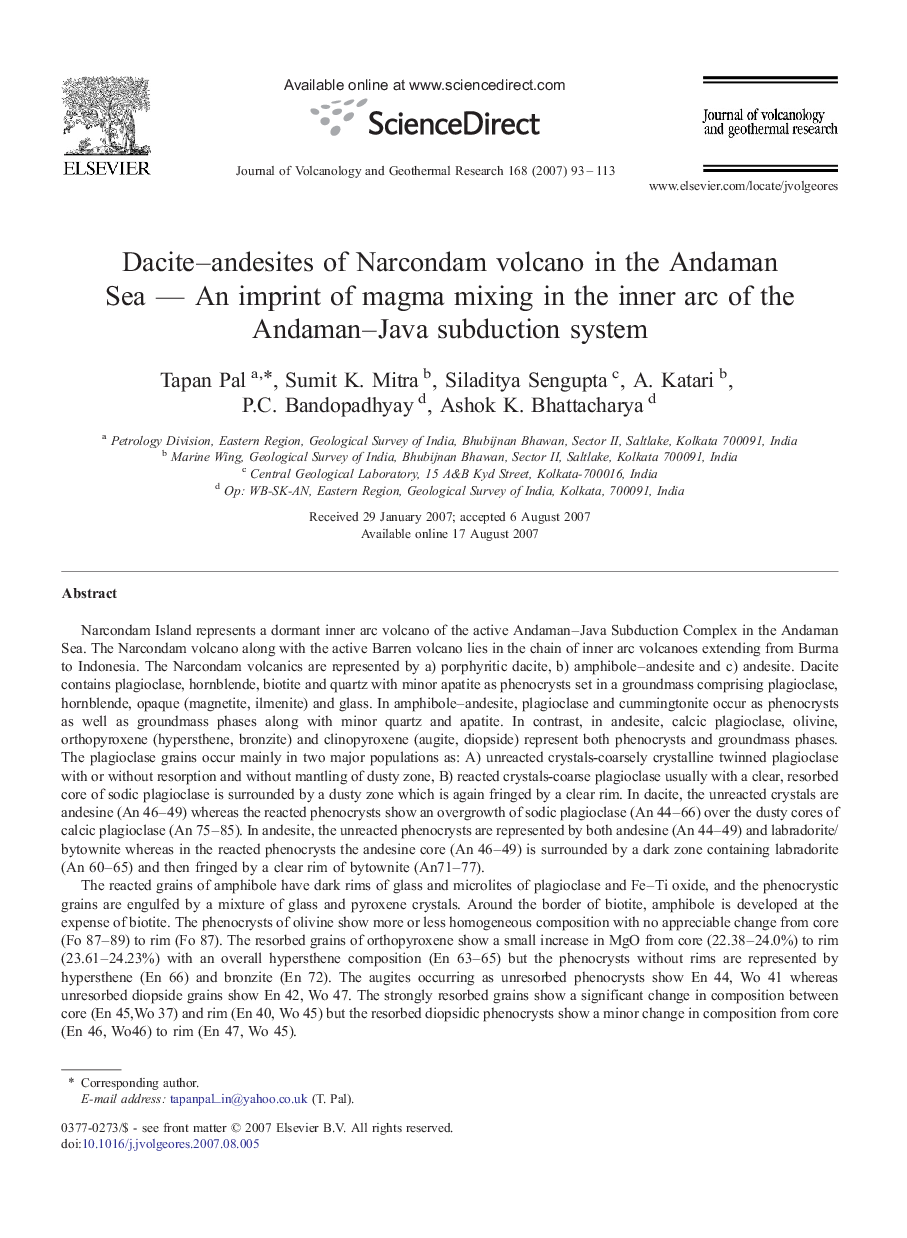| کد مقاله | کد نشریه | سال انتشار | مقاله انگلیسی | نسخه تمام متن |
|---|---|---|---|---|
| 4714806 | 1638457 | 2007 | 21 صفحه PDF | دانلود رایگان |

Narcondam Island represents a dormant inner arc volcano of the active Andaman–Java Subduction Complex in the Andaman Sea. The Narcondam volcano along with the active Barren volcano lies in the chain of inner arc volcanoes extending from Burma to Indonesia. The Narcondam volcanics are represented by a) porphyritic dacite, b) amphibole–andesite and c) andesite. Dacite contains plagioclase, hornblende, biotite and quartz with minor apatite as phenocrysts set in a groundmass comprising plagioclase, hornblende, opaque (magnetite, ilmenite) and glass. In amphibole–andesite, plagioclase and cummingtonite occur as phenocrysts as well as groundmass phases along with minor quartz and apatite. In contrast, in andesite, calcic plagioclase, olivine, orthopyroxene (hypersthene, bronzite) and clinopyroxene (augite, diopside) represent both phenocrysts and groundmass phases. The plagioclase grains occur mainly in two major populations as: A) unreacted crystals-coarsely crystalline twinned plagioclase with or without resorption and without mantling of dusty zone, B) reacted crystals-coarse plagioclase usually with a clear, resorbed core of sodic plagioclase is surrounded by a dusty zone which is again fringed by a clear rim. In dacite, the unreacted crystals are andesine (An 46–49) whereas the reacted phenocrysts show an overgrowth of sodic plagioclase (An 44–66) over the dusty cores of calcic plagioclase (An 75–85). In andesite, the unreacted phenocrysts are represented by both andesine (An 44–49) and labradorite/bytownite whereas in the reacted phenocrysts the andesine core (An 46–49) is surrounded by a dark zone containing labradorite (An 60–65) and then fringed by a clear rim of bytownite (An71–77).The reacted grains of amphibole have dark rims of glass and microlites of plagioclase and Fe–Ti oxide, and the phenocrystic grains are engulfed by a mixture of glass and pyroxene crystals. Around the border of biotite, amphibole is developed at the expense of biotite. The phenocrysts of olivine show more or less homogeneous composition with no appreciable change from core (Fo 87–89) to rim (Fo 87). The resorbed grains of orthopyroxene show a small increase in MgO from core (22.38–24.0%) to rim (23.61–24.23%) with an overall hypersthene composition (En 63–65) but the phenocrysts without rims are represented by hypersthene (En 66) and bronzite (En 72). The augites occurring as unresorbed phenocrysts show En 44, Wo 41 whereas unresorbed diopside grains show En 42, Wo 47. The strongly resorbed grains show a significant change in composition between core (En 45,Wo 37) and rim (En 40, Wo 45) but the resorbed diopsidic phenocrysts show a minor change in composition from core (En 46, Wo46) to rim (En 47, Wo 45).The trace element abundances do not show differences between amphibole–andesite and andesite. The distribution pattern of trace elements for dacite to amphibole–andesite to andesite is also similar except for low Cr and Ni for dacite. Dacites contains slightly higher Rb, Sr and, Zr than those in amphibole–andesite and andesite. The variation diagram of trace elements indicates that LIL elements are enriched relative to HFSE e.g., Zr, Ti, Y as well as a strong positive anomaly in respect of N-MORB.The textures as well as compositions of the phenocrysts of the volcanics exhibit disequilibrium caused by magma mixing. The sodic plagioclases, occurring as unreacted grains in dacite and as cores of the reacted grains in andesite, as well as the presence of rhyolitic glass as inclusions, record rhyolite as one magma source. On the other hand, preponderances of phenocrysts of basaltic origin (high Fo olivine and Mg rich pyroxene) as well as basaltic glass as matrix and inclusions in the phenocrysts in andesite suggest basalt as another source magma. In reacting grains showing fresh andesine, the core was derived from acid magma and the reacting zones showing labradorite composition were developed by the reaction of andesine crystals with hot basic magma. In andesite, unreacted grains of andesine and labradorite/bytownite were trapped from the evolved dacitic magma and basaltic magma respectively. During super-heating of dacite magma by basic magma biotite was replaced by amphibole as a result of dehydration. Olivine grains were replaced by pyroxene during gradual cooling of basaltic magma and magma mixing. The presence of mixtures of phenocrysts of both the magmas and glasses of the source and intermediate magmas indicate that dacite, amphibole–andesite, and andesite are the products of magma mixing.
Journal: Journal of Volcanology and Geothermal Research - Volume 168, Issues 1–4, 15 November 2007, Pages 93–113